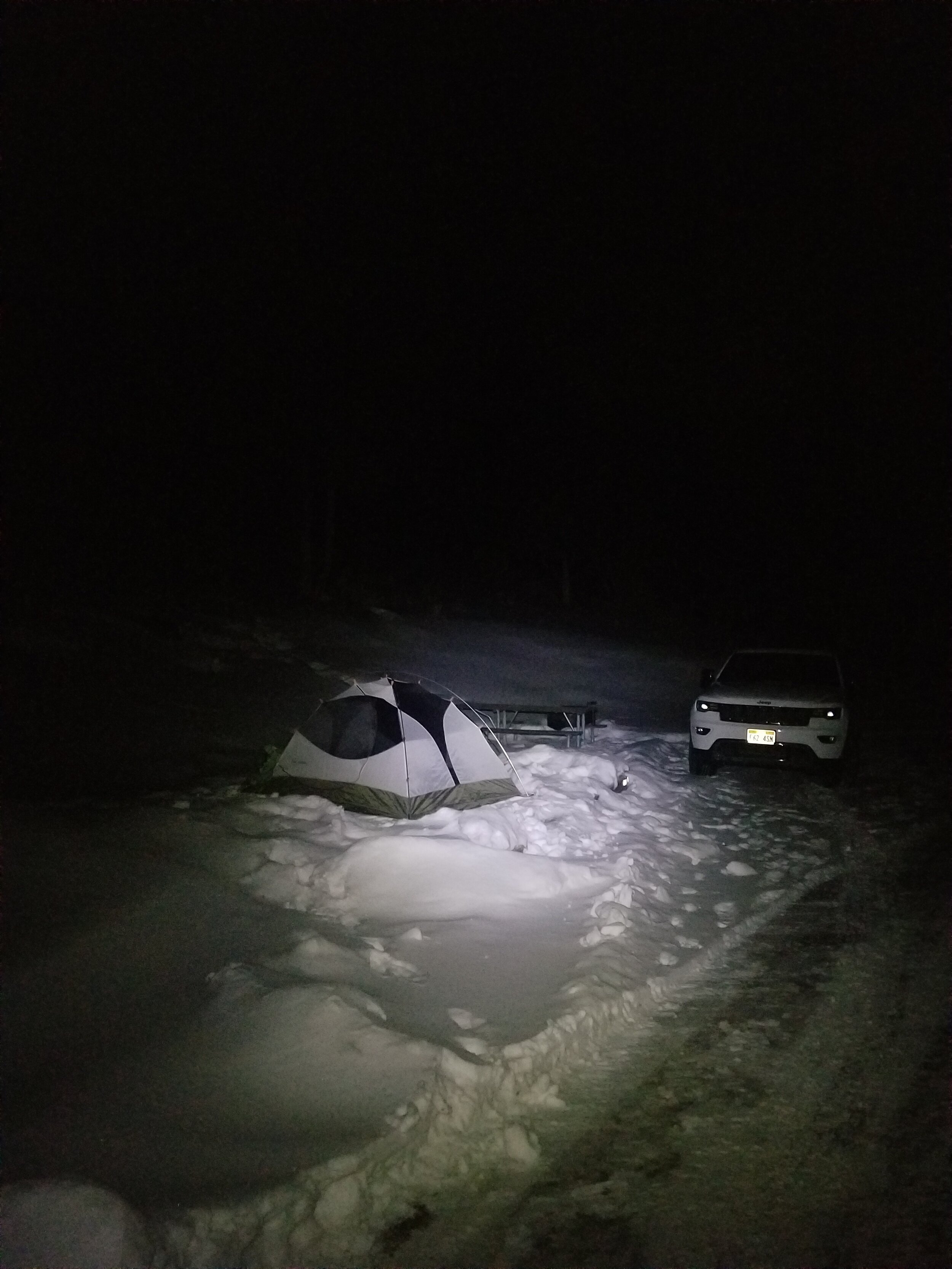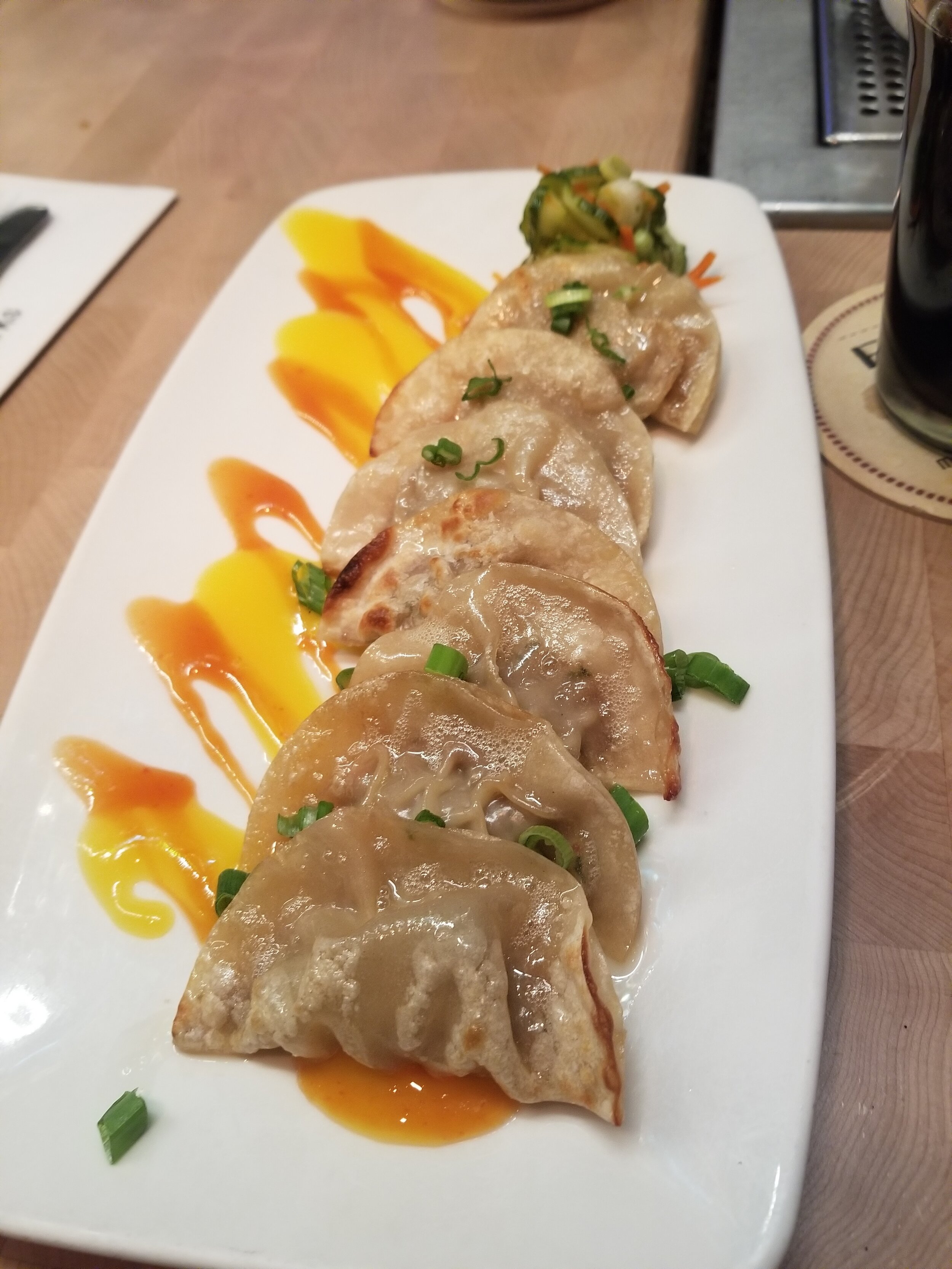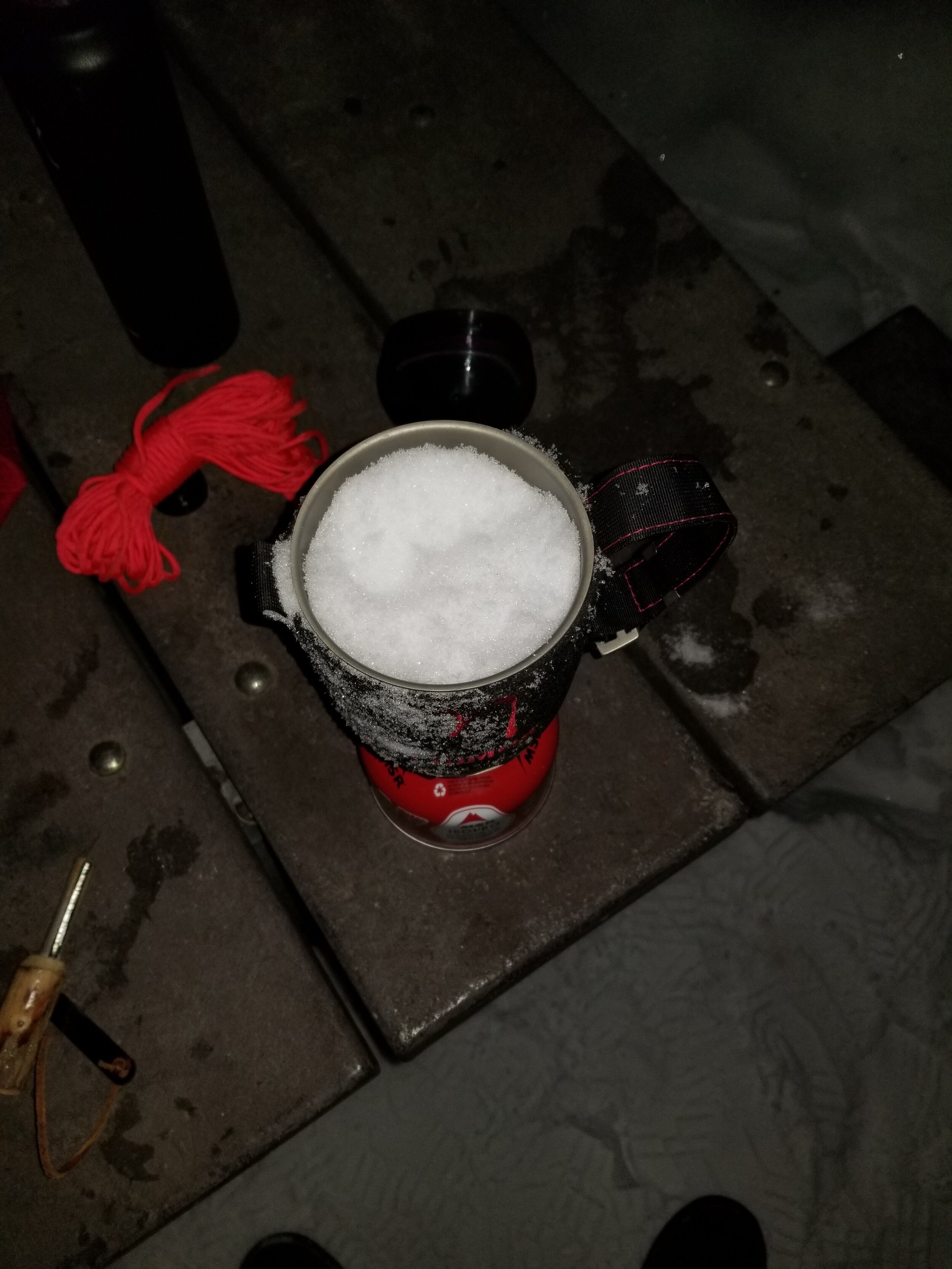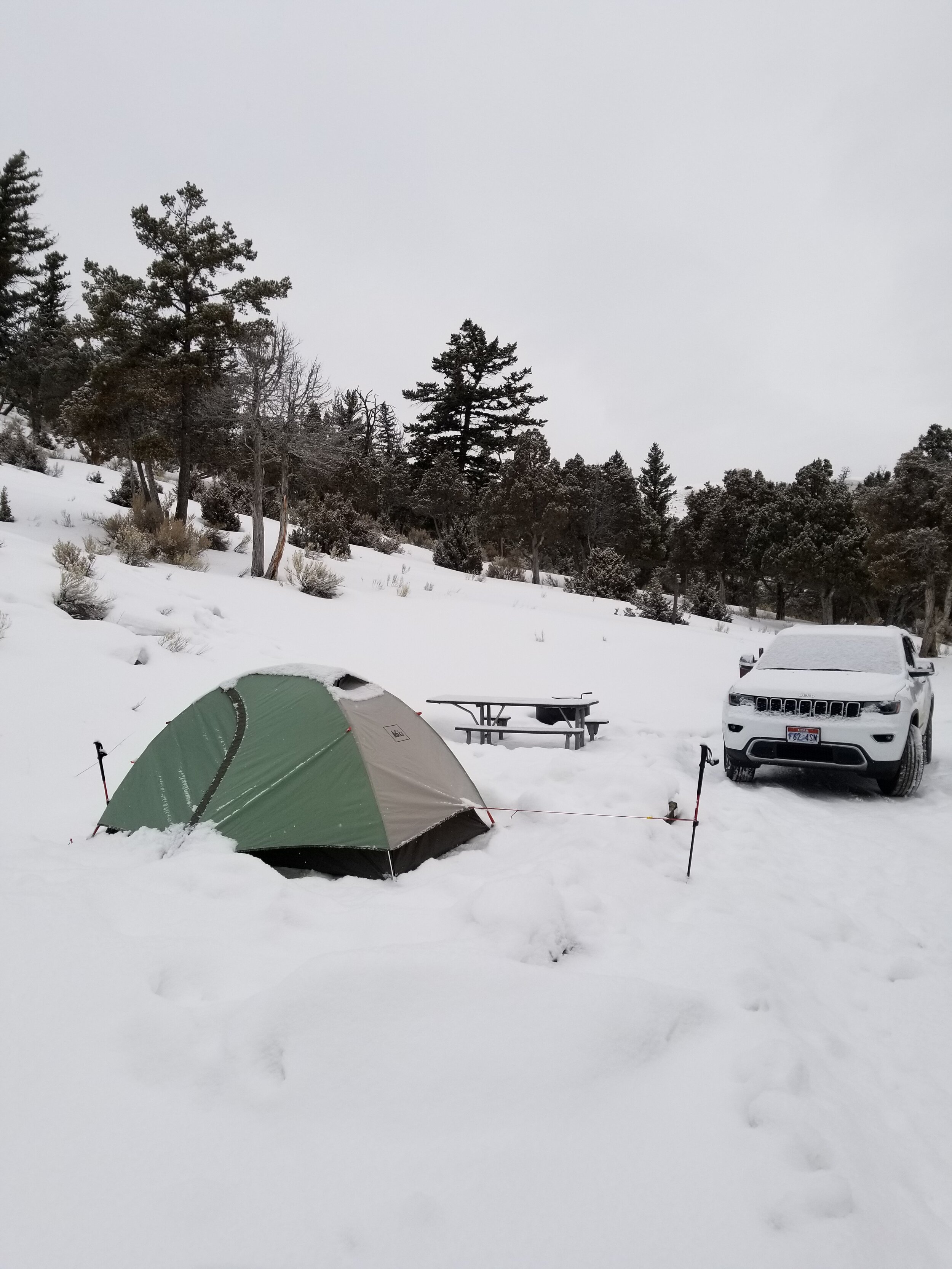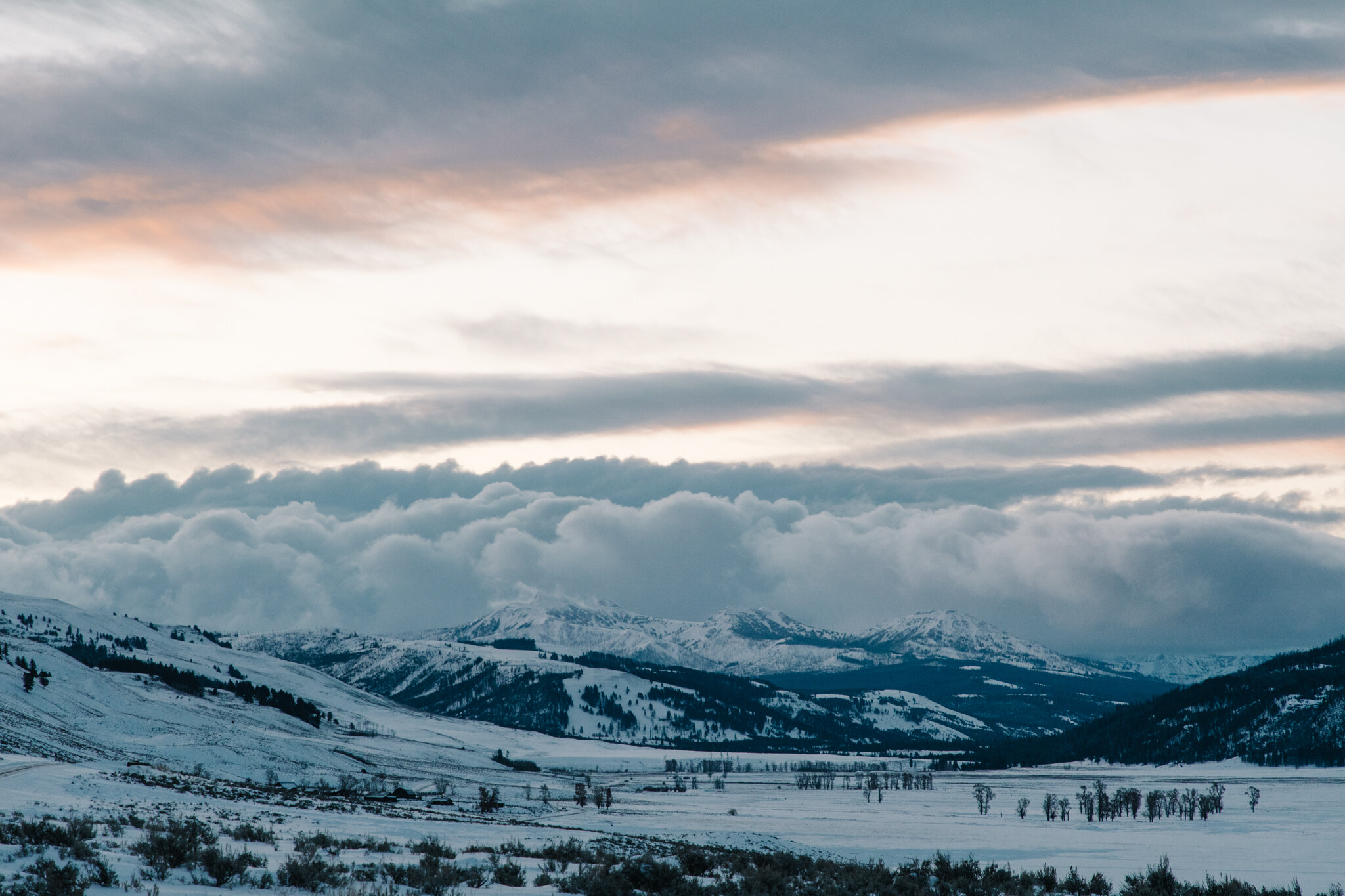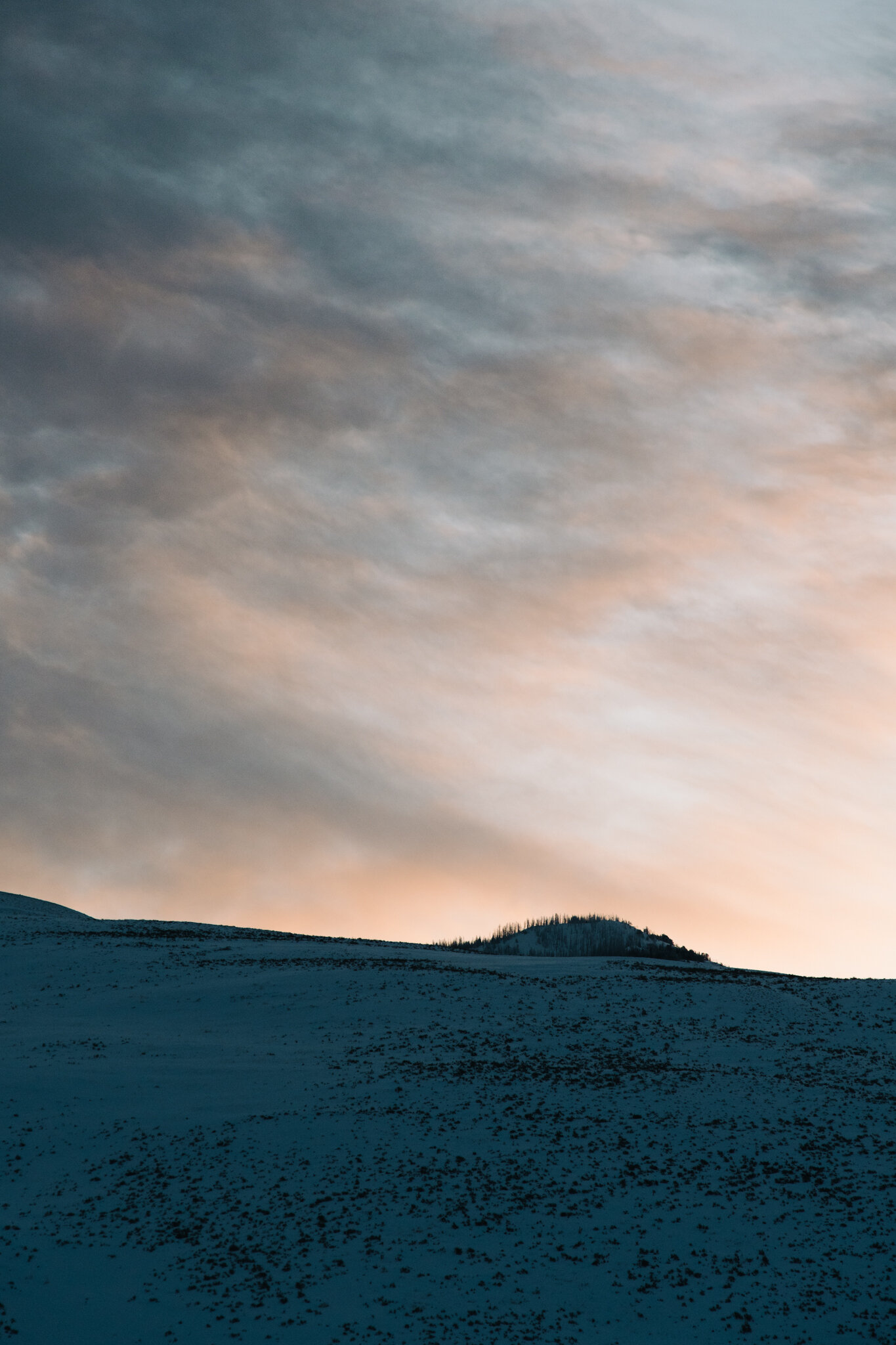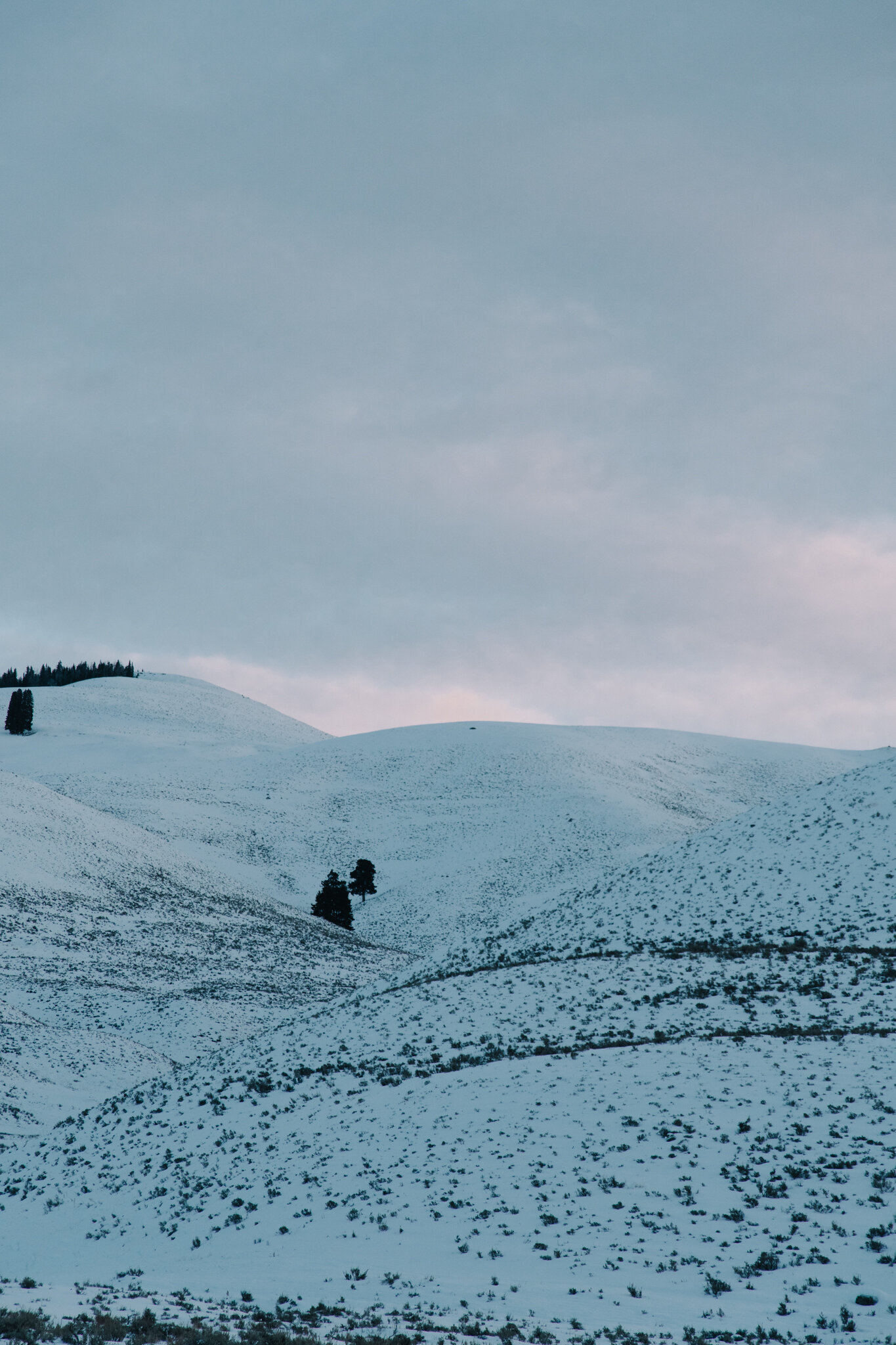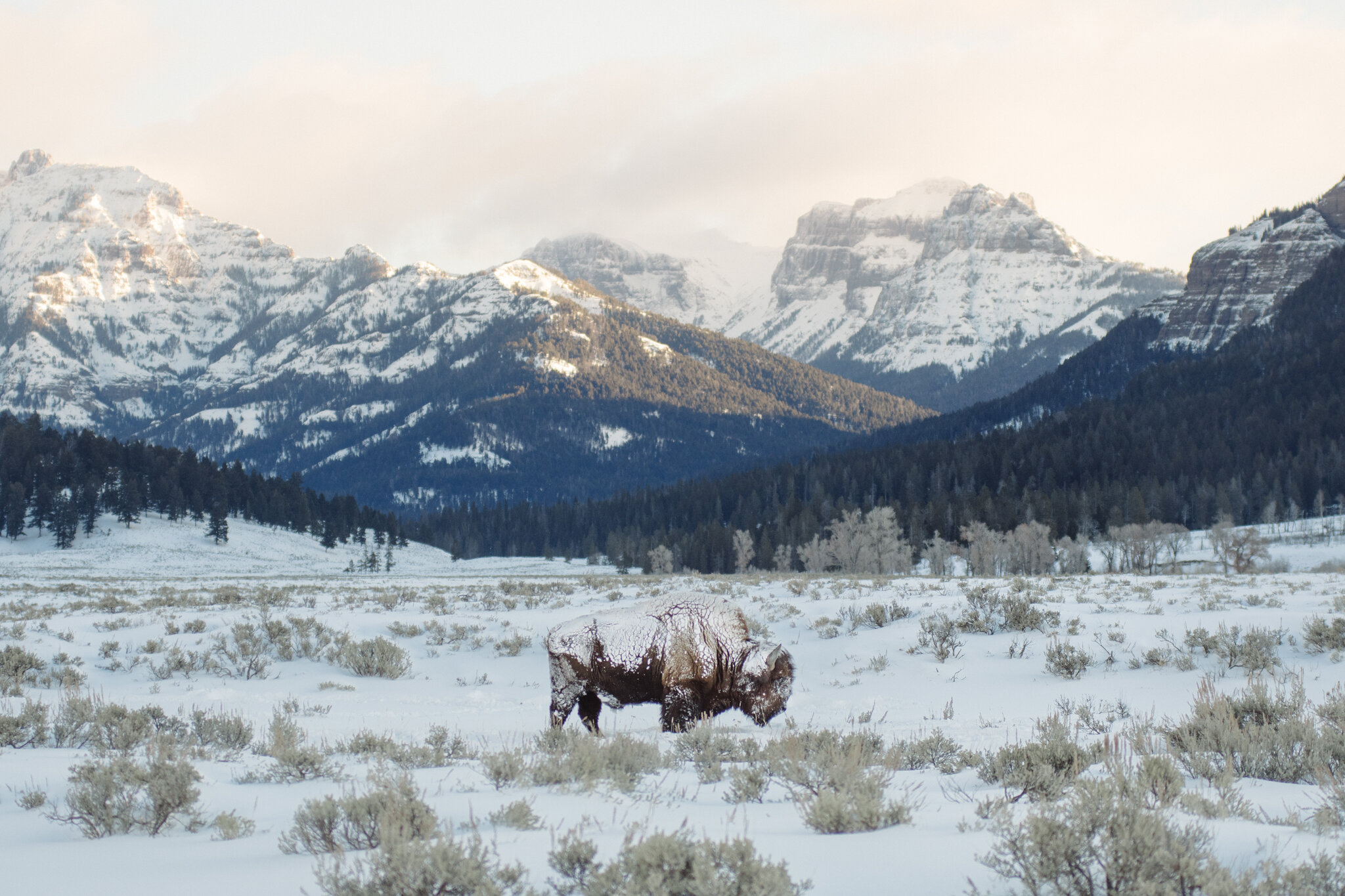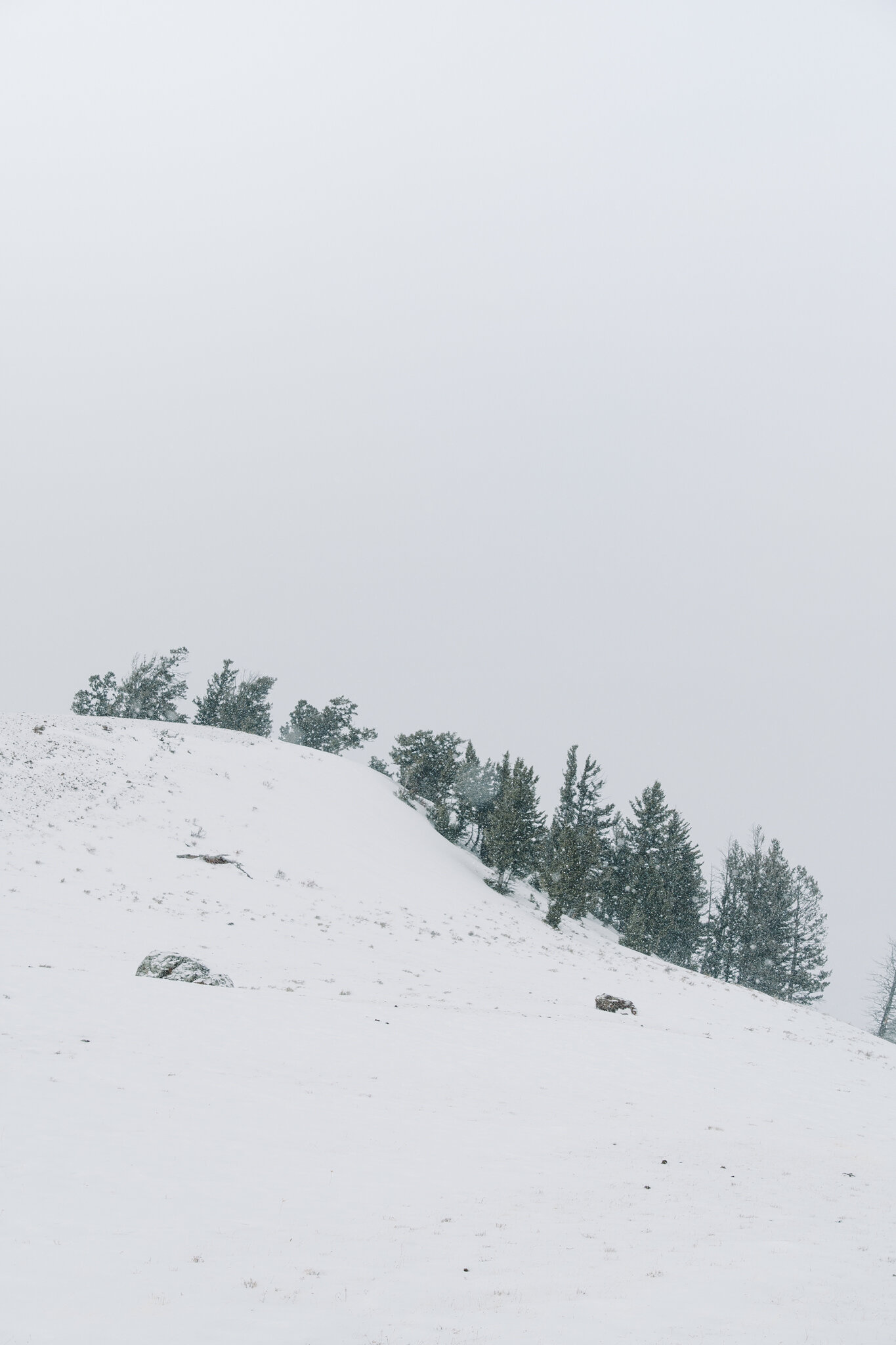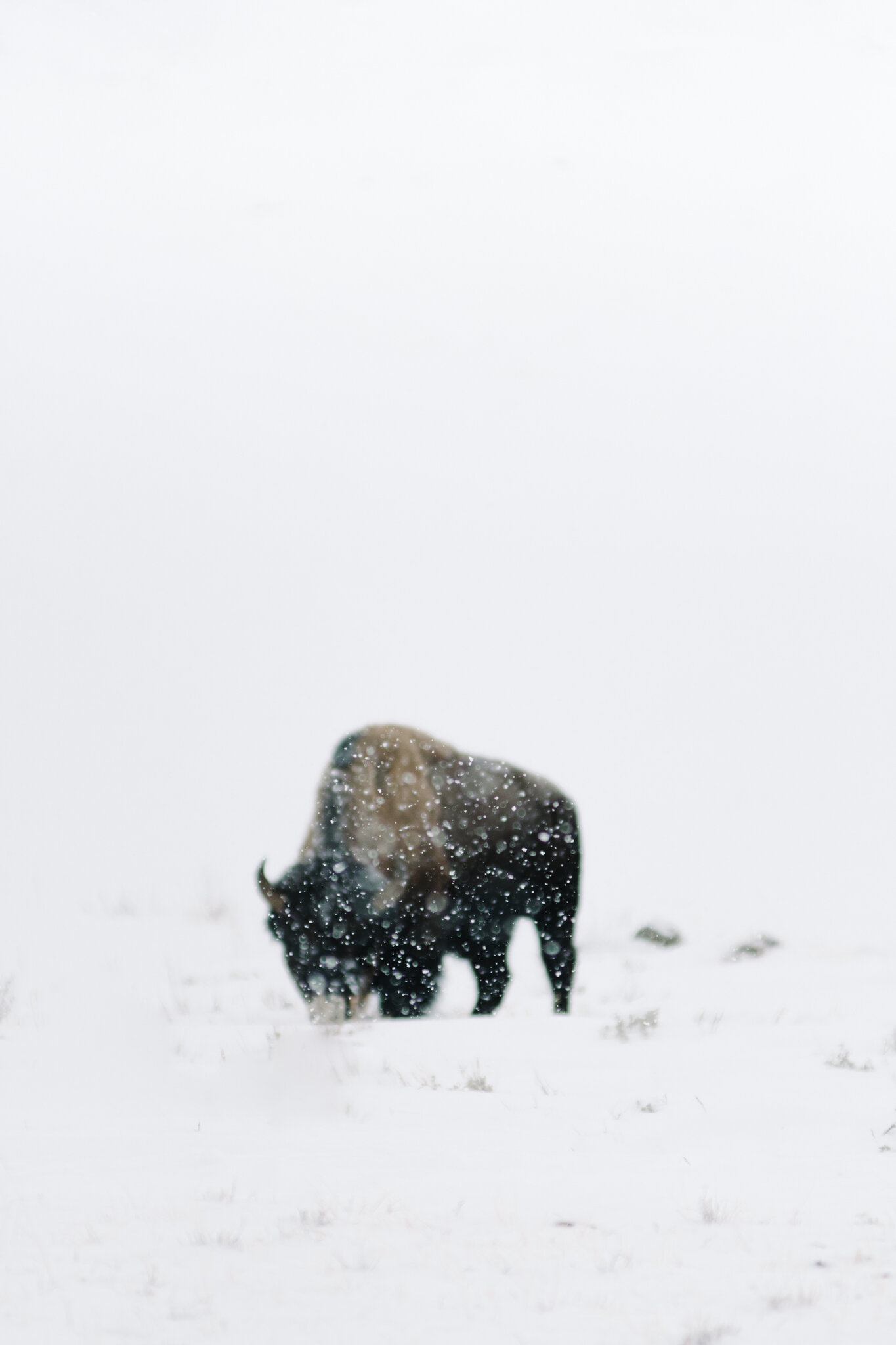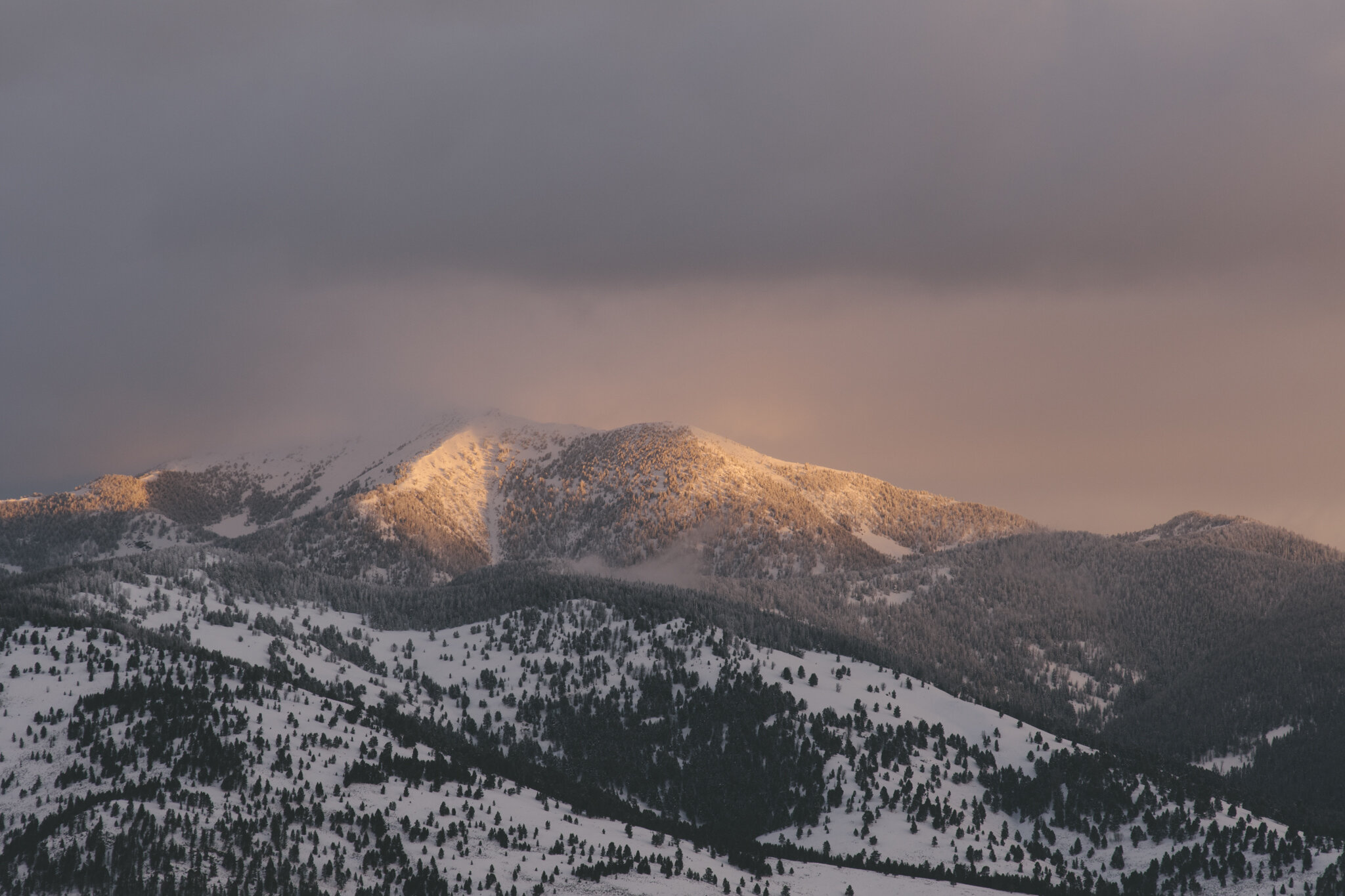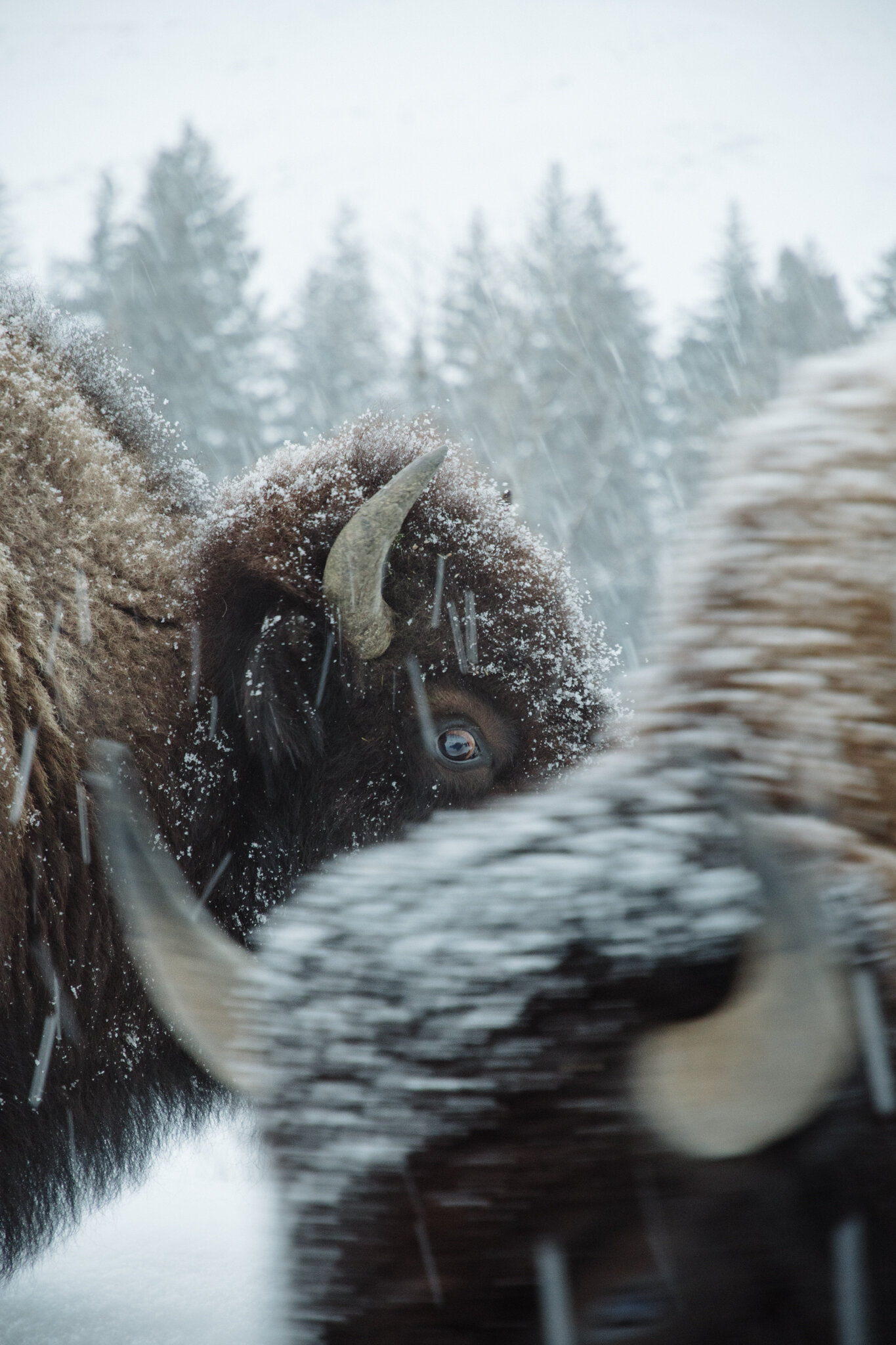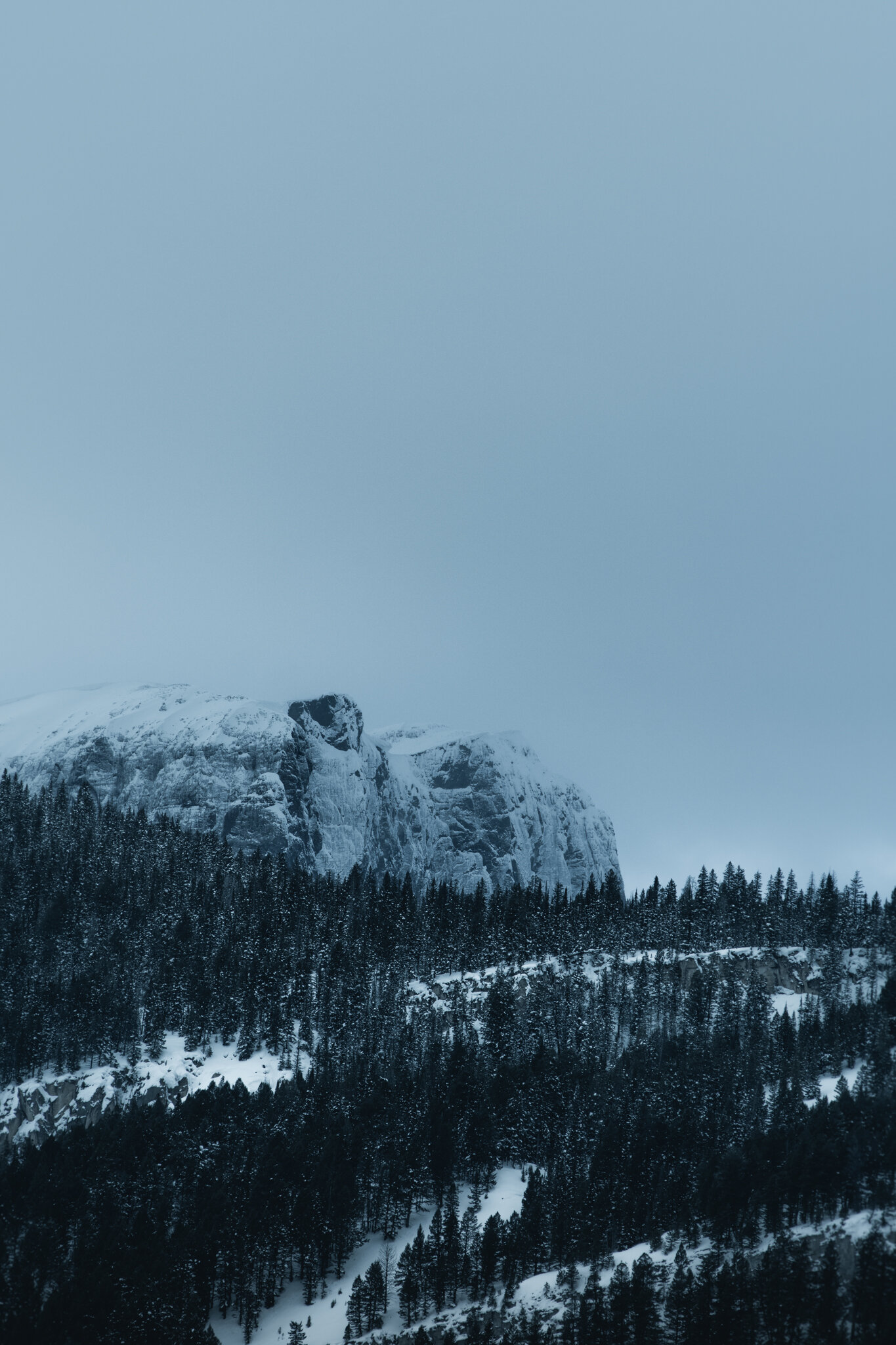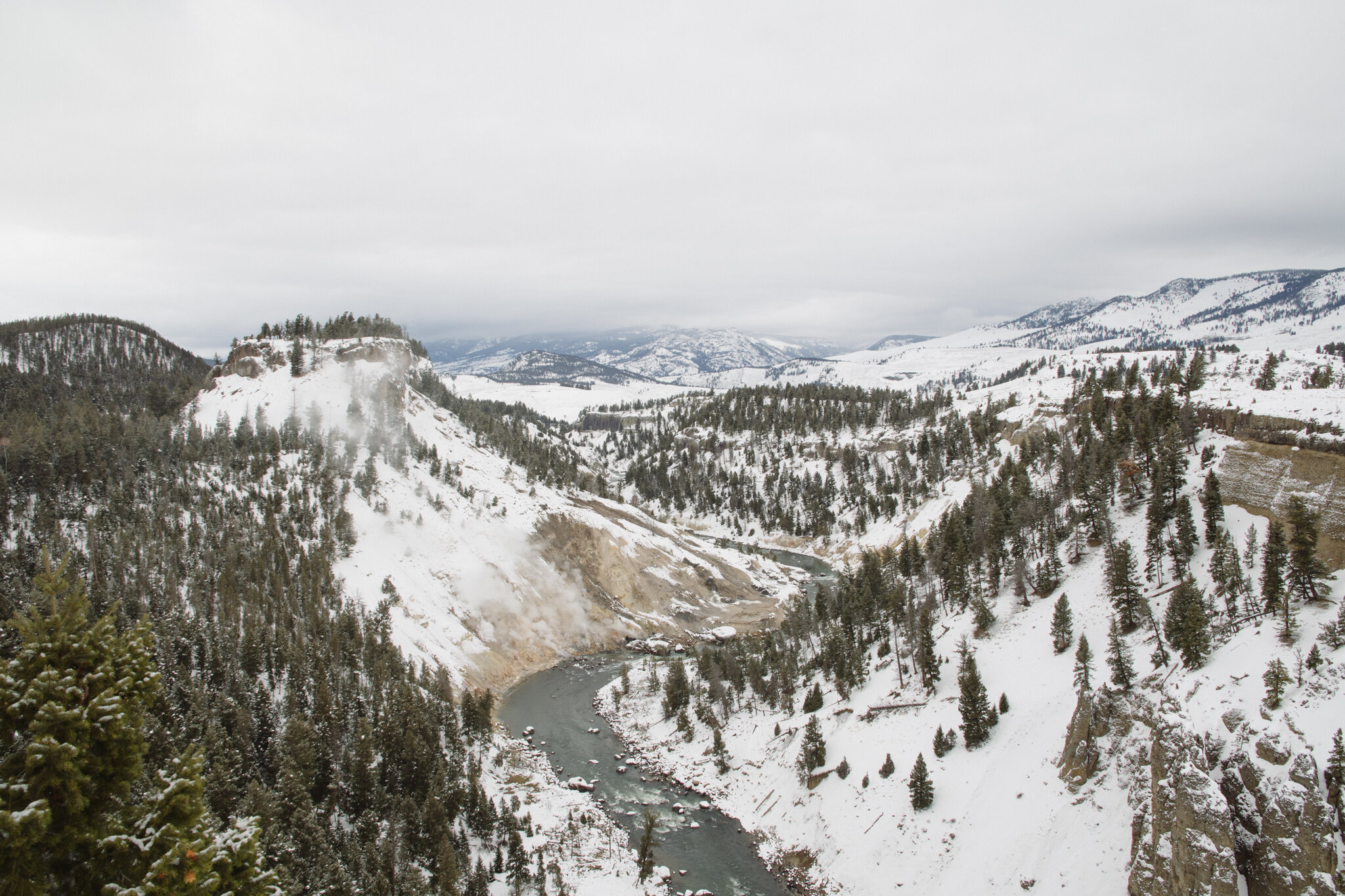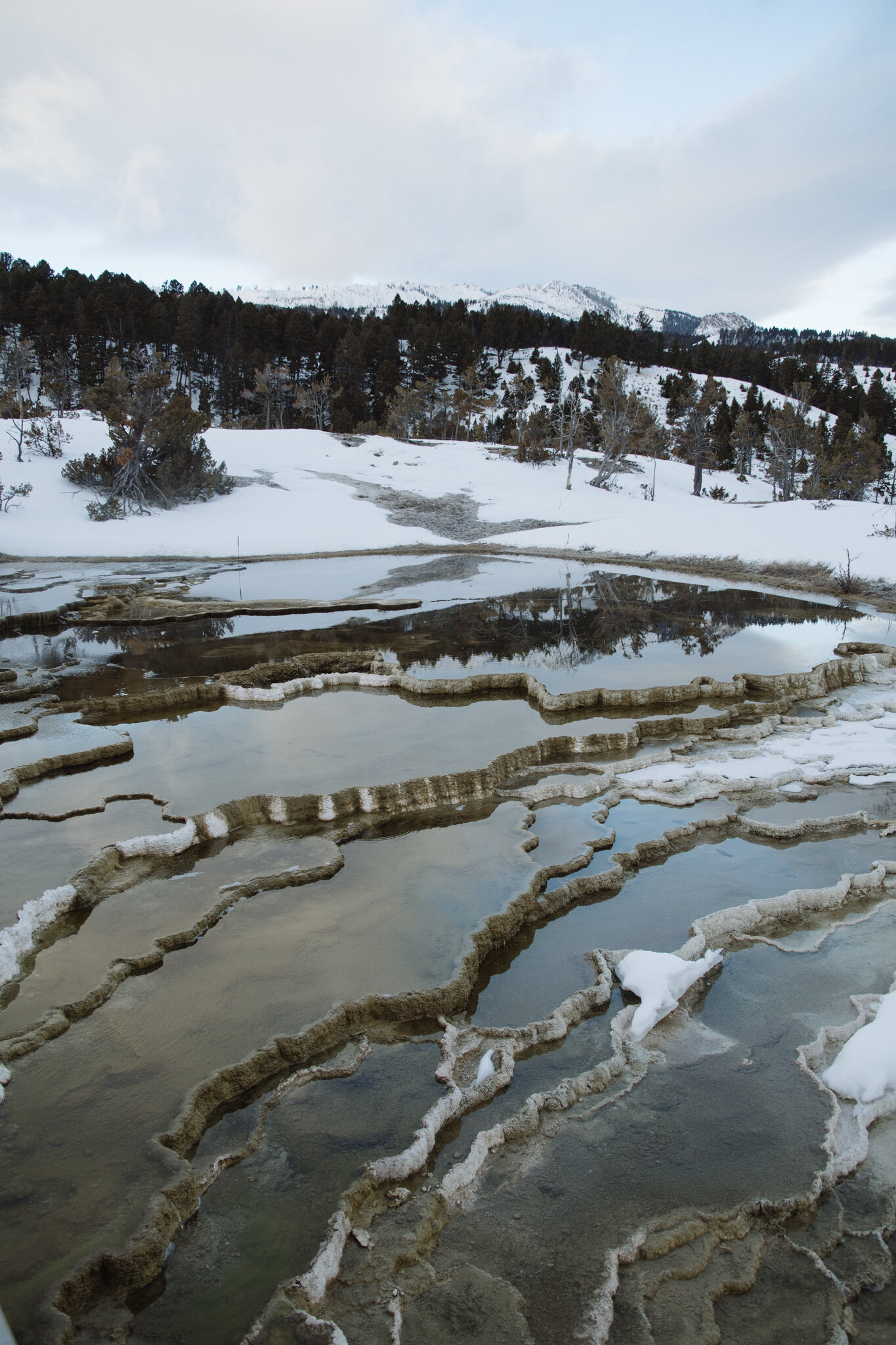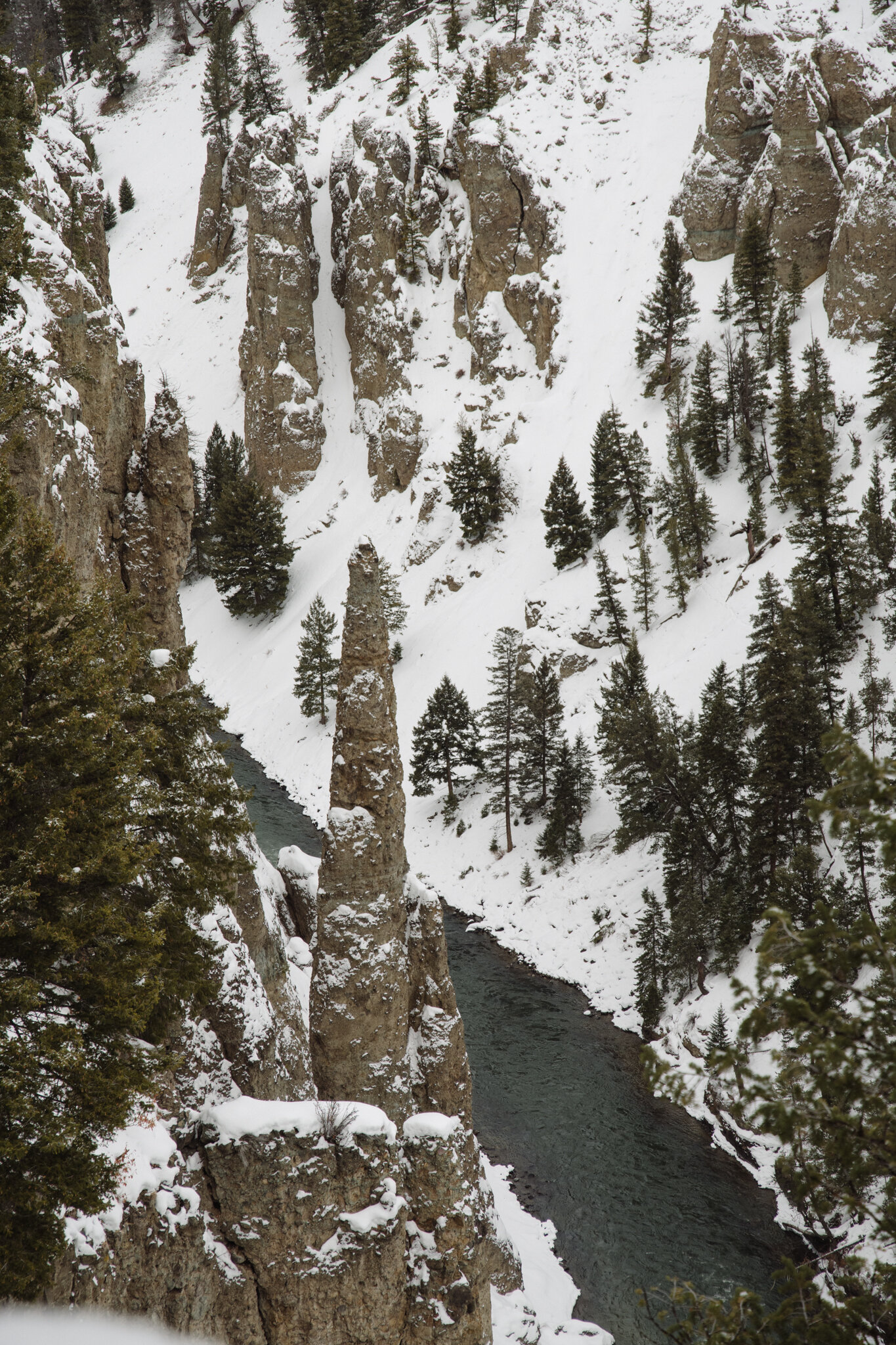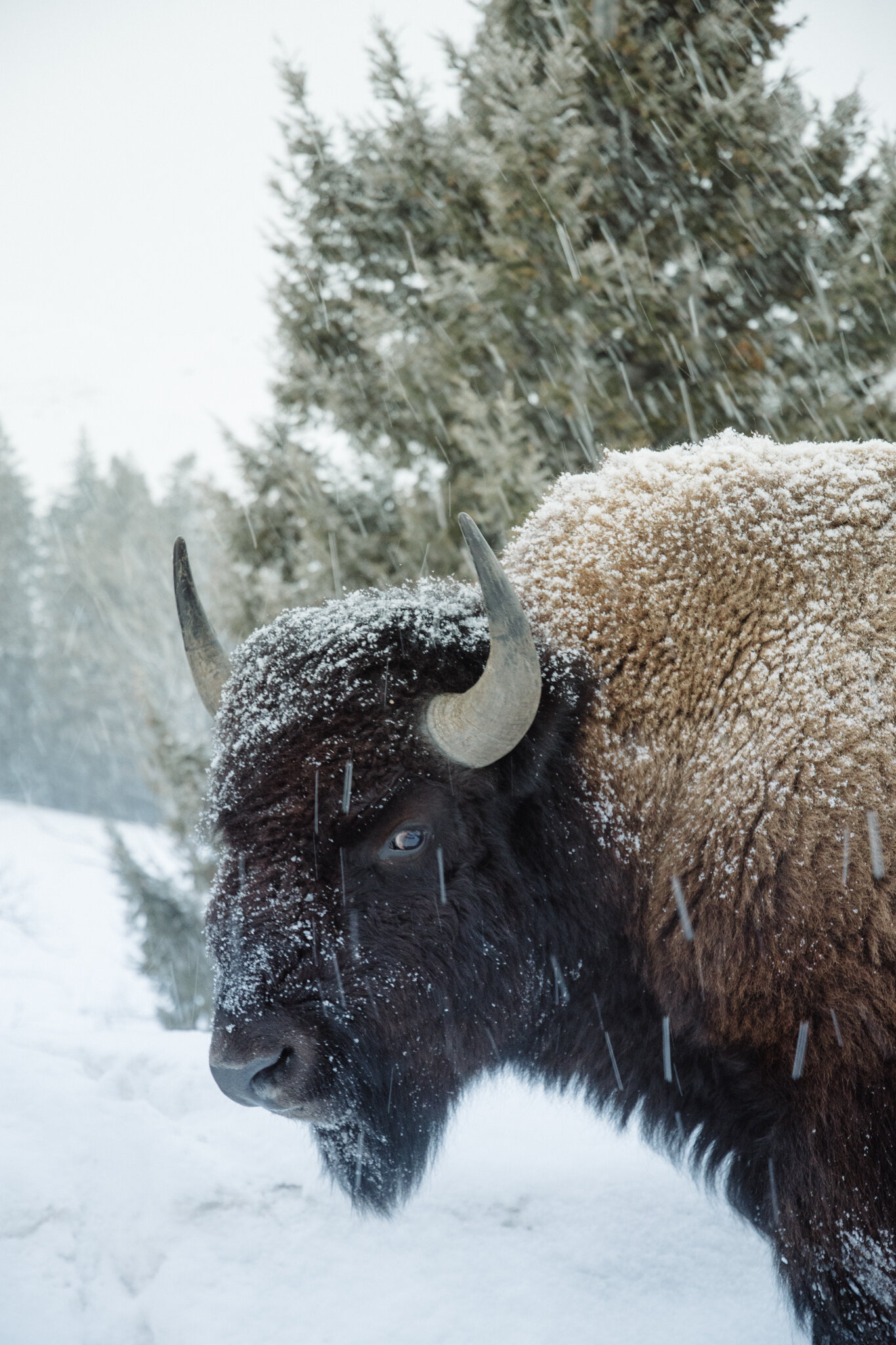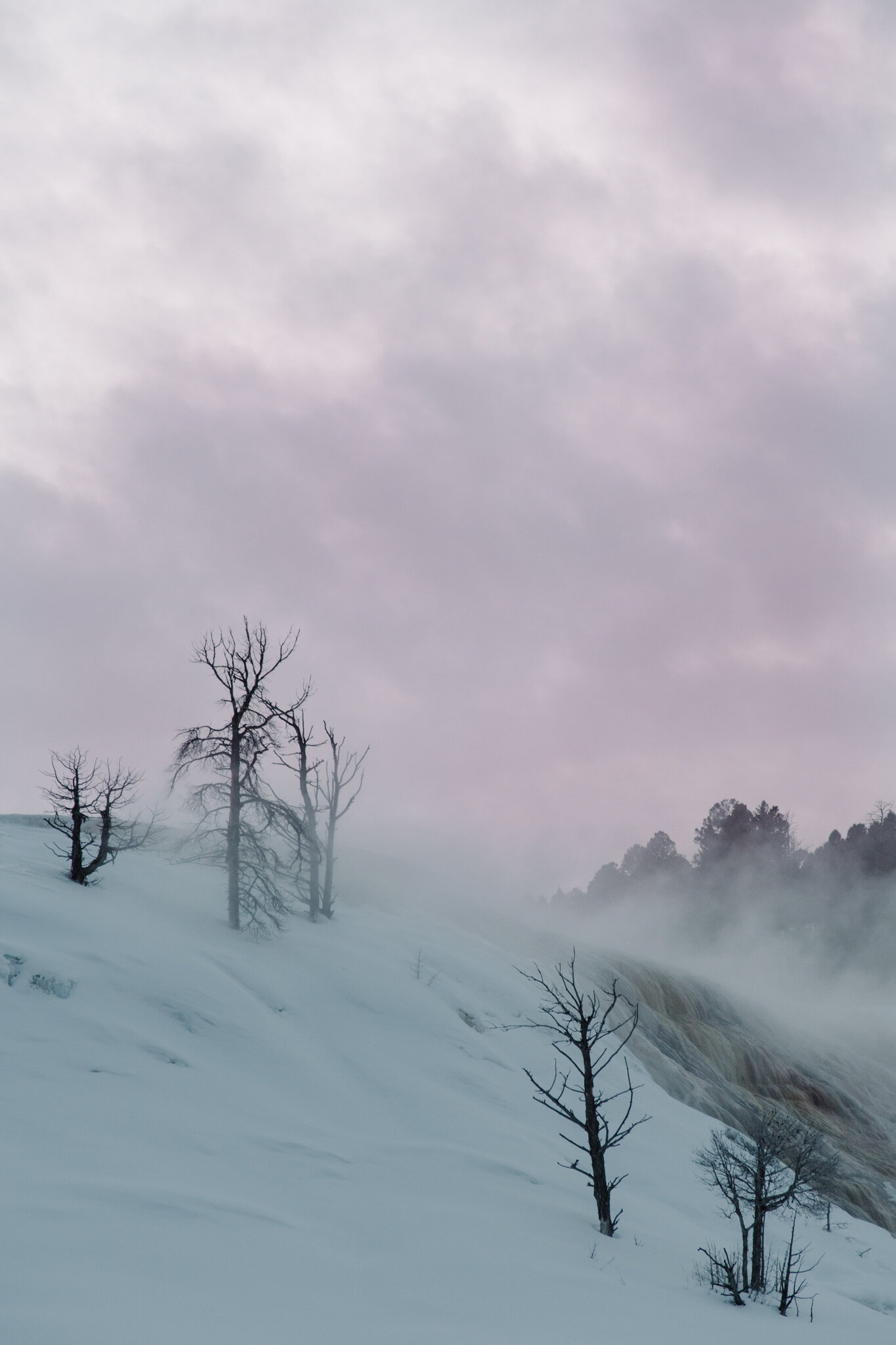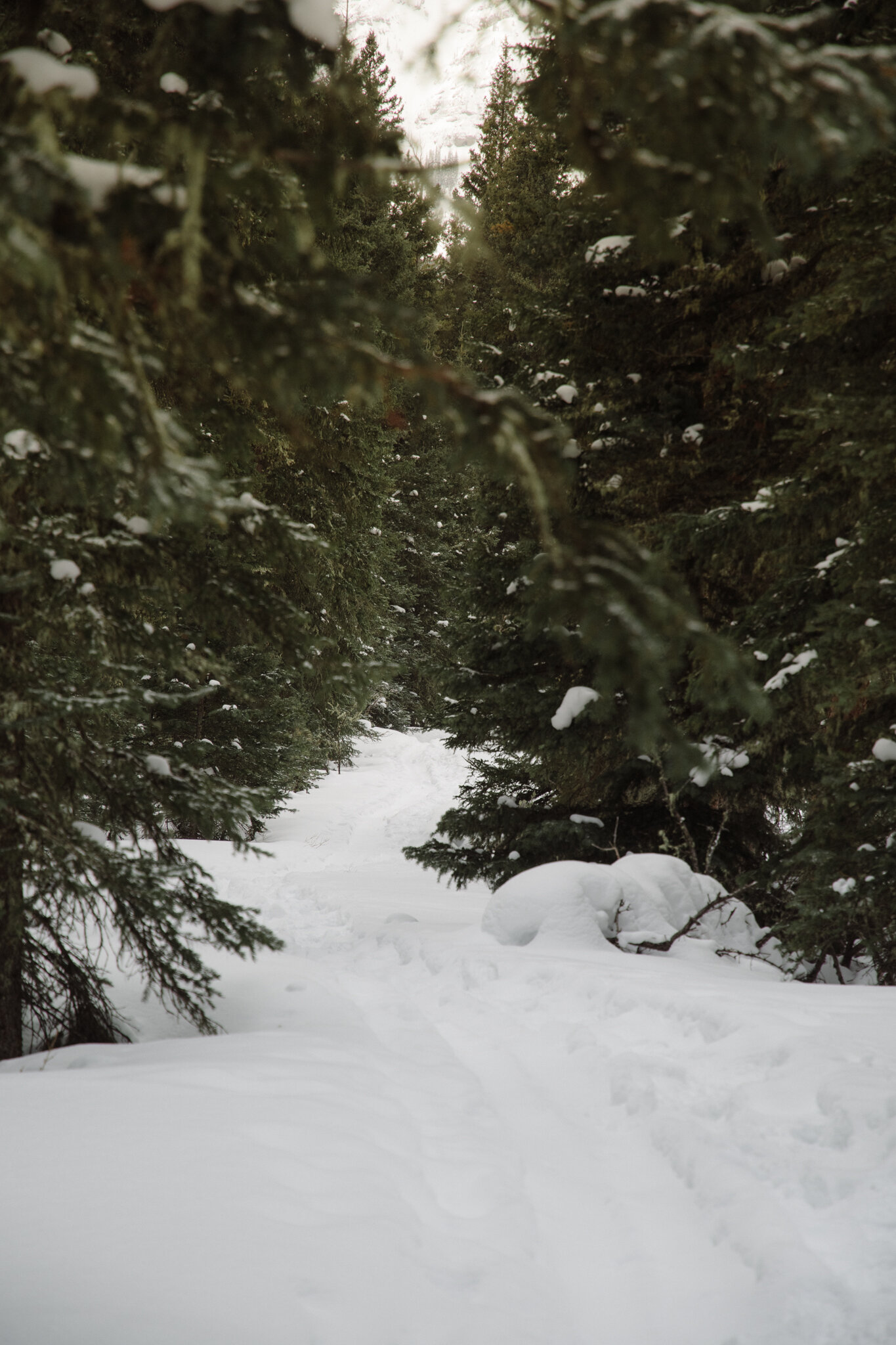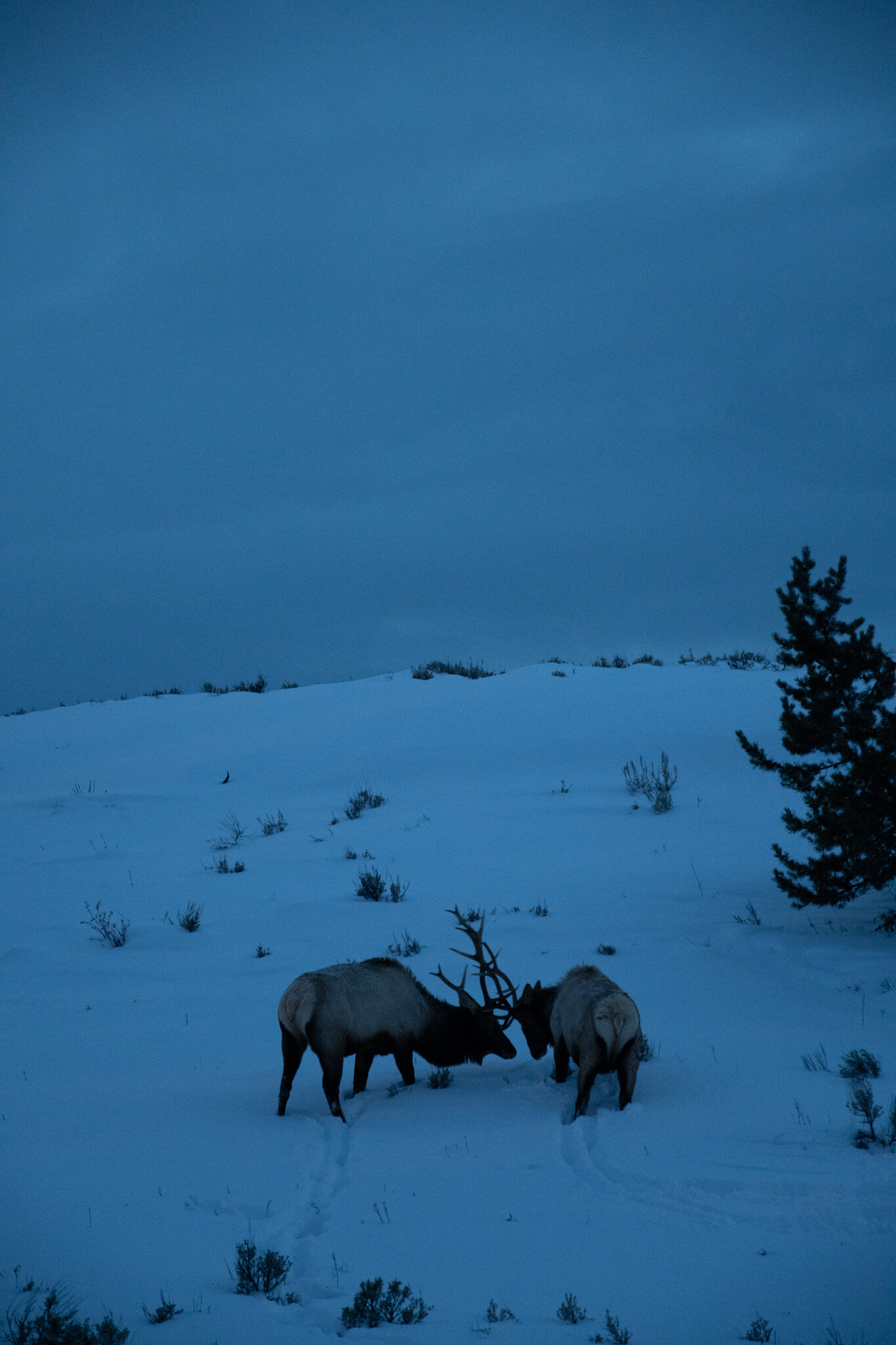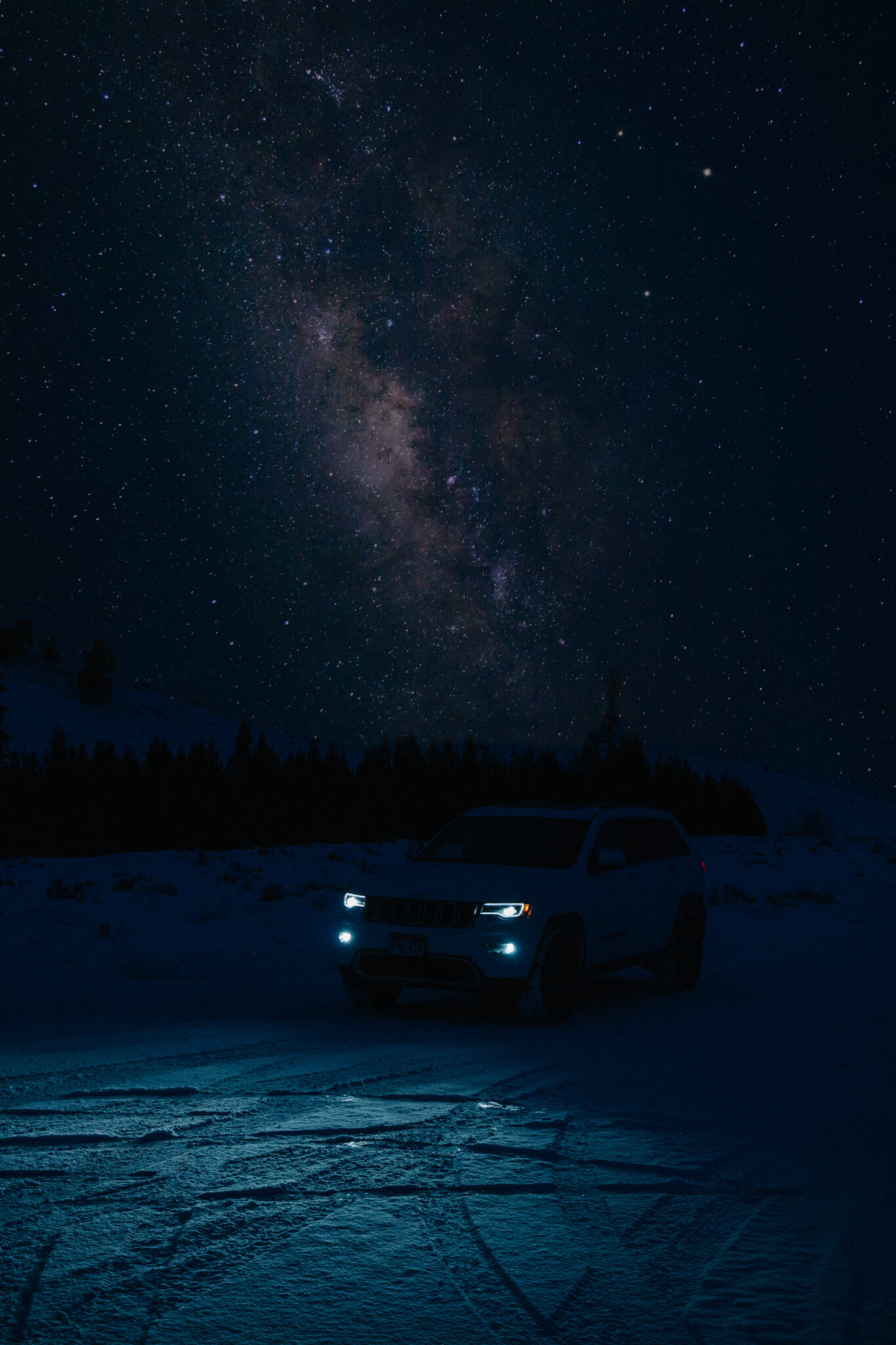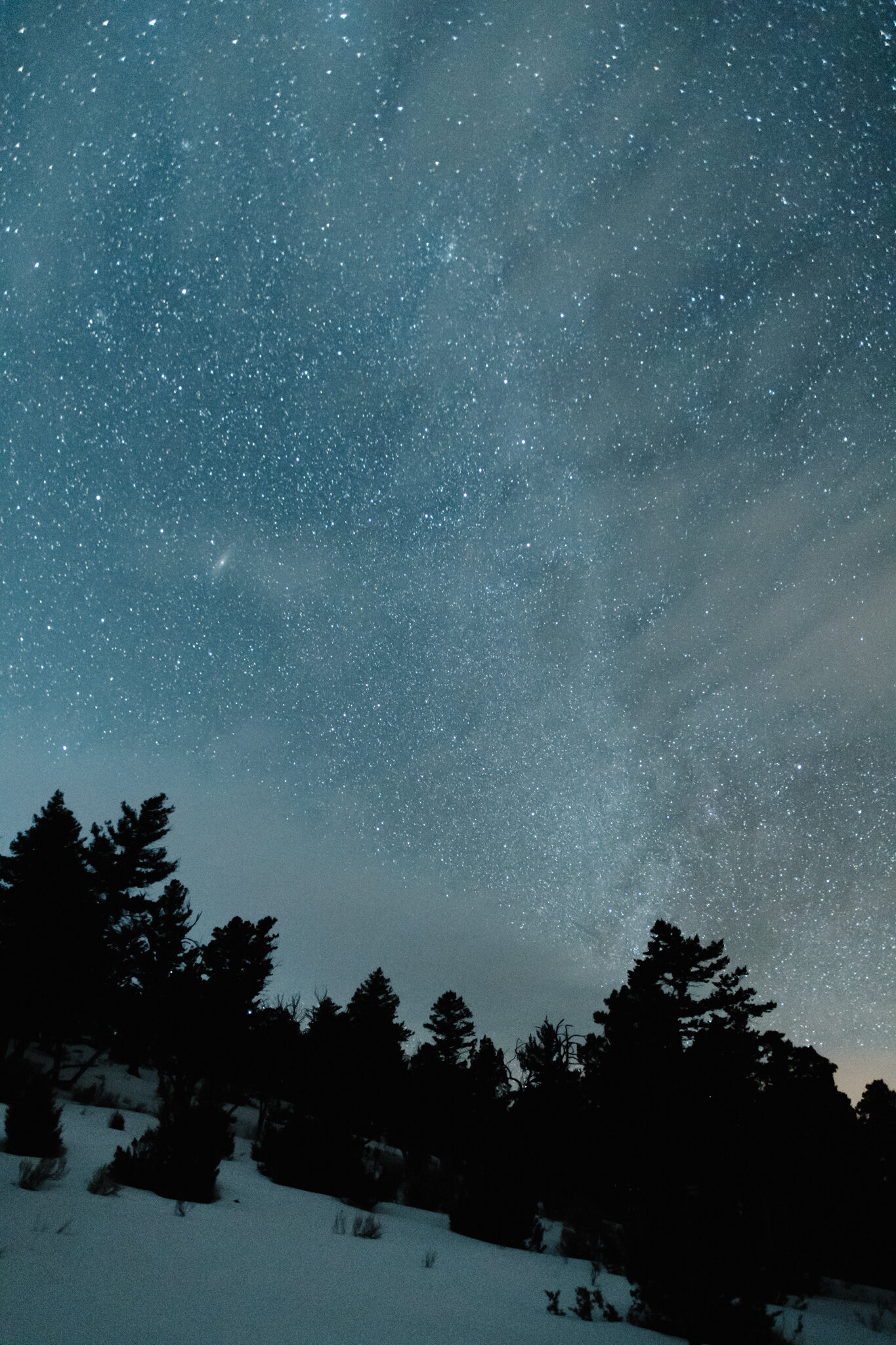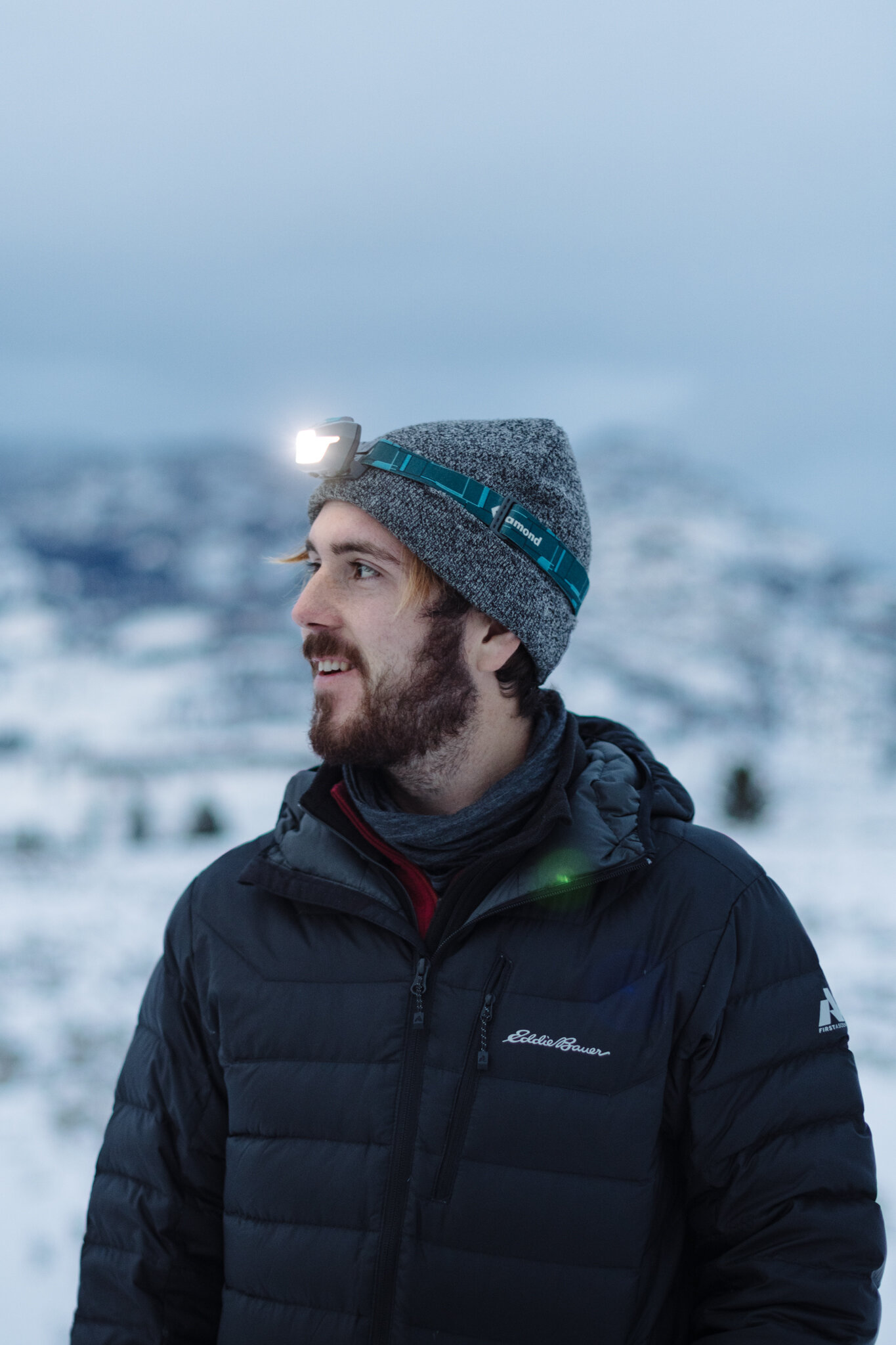Arriving
It was with a touch of hesitation that I uprooted myself from the barstool in Bozeman to head an hour and a half south towards the North entrance of Yellowstone National Park. With the sun just about set, the prospect of arriving at my campsite under nightfall in sub-freezing temperatures was, albeit exciting, a rather abstract concept and somewhat difficult to look forward to after a full day of plane travel. Nonetheless, after a brief and discouraging look for airbnb’s in the area I closed out and hit the road.
The drive was pitch black and fortunately I only encountered one group of stubborn elk in the roadway. Driving through the night to Yellowstone was borderline disorienting: the black sky and landscape void of any artificial lights left me no reference for the landscape that surrounded me. It wasn’t until I entered the park that I could vaguely make out impressively craggy ridgelines against the stars that were visible between cloud cover. Still, I had no idea what daylight would uncover the following morning.
Camping in Yellowstone in the winter months is an interesting experience. First things first - most of the park roadways are actually closed and buried under (at least) several feet of snow, making the Mammoth Springs Campground the only developed choice. The other option is to drive to a trailhead along the one road that’s open, ski or snowshoe your way into the backcountry, dig yourself out a campsite, and start melting snow for drinking water. Oh, and you’ll need to bring some designated “waste bags” for yourself, because everything needs to be packed out of the backcountry here under Leave No Trace guidelines (yes, even your own poop). Although that sounds like quite an adventure, I figured I already had enough on my plate with this being the first time me and my gear setup would be tested by a Rocky Mountain winter. Mammoth Campground it was. I don’t usually stay in campgrounds in the National parks, as they fill up quick and backcountry is usually much more my preferred style. During January in Yellowstone though, the usual trends are broken. I arrived at 8pm with no reservation and had my pick of tent sites as one of three campers in the entire facility. That’s mostly because, as you would expect, it’s a damn cold place. I was actually lucky to come into camp on an unusually “warm” night when it was about 15°F at the site. The nearby thermal features and lower elevation in this area help keep it a few degrees warmer than the rest of the park. I made camp, melted some snow for some sleepy-time tea and hopped in my sleeping bag before it got too late. The silence of the place was only broken by the yelps and calls of the coyotes, who, at one point I was sure were moving right through my site. It felt good to be back in the Rockies…
Some scenes from arrival in MT, including bison dumplings from Montana Aleworks in Bozeman, getting into camp after dark, melting snow for some before-bed tea, and A+ canned camp food.
Acclimating
With my body clock still on an Eastern Time rhythm, I woke ahead of the sun and figured I should head into the valley to catch the sunrise. My Jeep rental was reading 8°F, my boots were thankfully dry, but sincerely cold. I checked my park map and headed out of the campsite with my hydroflask full of some hot tea for the road. About 3” of snow had come overnight at Mammoth Springs, and apparently more east of Yellowstone Village. As I headed towards Lamar Valley (what everyone told me was the promised land of Yellowstone) the sky began to take on a blue luminance and the stars slowly faded from sight. I saw a dark mass in the snow about 50 meters off the road and excitedly stopped to confirm my suspicion. A Bison! only about 30 minutes into my first morning in the park! I felt so lucky to be spotting iconic wildlife so early on. Of course, it was only me being naive - this species in particular would outnumber humans in the park ten fold, and be the cause of road and trail delays over the course of the next 5 days. Alas, it was a promising sight for a first timer. The drive to Lamar Valley gradually grew more impressive as the sun rose to reveal the insane geography of Yellowstone. There is this one turn in the road when you’re arriving from the West of the valley where you crest a small hill and then you glimpse the valley in full for the first time. I was amazed, staring through my windshield at some of the most dramatic landforms I have ever seen. The trees in the valley look like toothpicks against the mountains that dwarf them on either side of the creek. The Rockies far off behind them rise up so high that at first glance you could mistake them for clouds. Bison, appearing as small as ants meander calmly through the valley or on slopes where the sedges poke through the snow.
sights of the Lamar Valley at sunrise
Wandering
Wake up, clear tent fly of snow, make tea, oats, fight with magpies over oats, pack daypack, get into hiking clothes, visit ranger station for trail information, hit road, hit trail.
Walking in a Yellowstone winter means strapping on snow shoes or skis and traversing the backcountry or open roads which are transformed into groomed trails in the colder months. I learned after a futile effort to cover all of about 2 miles over 4 hours on my first day that the latter was my preferred avenue, despite yielding a slightly less “wild” feeling. Apparently, snow shoes don’t give the Legolas like ability to walk lightly on 4 feet of powder like I had hoped for. The groomed trails still enable access to some truly remote feeling areas, and add the fact that on a given day hikers are likely to see about 1-2 people out on the trail, you may as well be deep in the backcountry. Solitude is easy to come by. For the second time in my life, since my first winter overnight trip in the Appalachians, I was able to hear the sound of snow falling. For someone who has lived in suburban / urban areas for my whole life, the level of silence it takes to hear the crinkling of snowflakes accumulating is extremely rare.
The days mostly brought whiteout conditions, where only for a moment would distant mountains reveal themselves from behind impressive curtains of snow. At times it was like I was traversing a soundless, colorless landscape with almost no horizon or scale reference. Cresting a mellow slope on one hike, I quickly gained perspective when I locked eyes with a fully grown Bison stubbornly occupying the trail. Though calm about it, he showed no interest in yielding and so I elected to hike up and over the nearest hill to steer clear. At the top, I stopped for a rest and spotted a skier in the valley below, coming from opposite me but headed for the same “road block”. At some point I guess he saw me up on top of the hill because I watched as he approached the bison, reluctantly popped off his skis, and hauled them up the hill to my position. “D’youknow that’s twice I’ve gone ‘round ‘eem now!” he said in an unmistakeable english accent. After chatting for a few minutes I learned that this guy was a London Native, living in Las Vegas for 6 months a year as he was a professional gambler, and also happened to have a sincere love for the outdoors. We talked about our first impressions of Yellowstone, about the 6-8ft supertelephoto lenses that every damn roadside tourist in the park seemed to be wielding, and how stopping in rural bits of Montana on our way to the park helped us understand the whole “Trump thing” in America…
Back on the trail, it isn’t only uncommon to wind up amidst giant animals. All throughout Yellowstone lie impressive geographic features of varied origin, many of which are sill actively volcanic. Sulfur aroma escapes from thermal vents and springs and cruises the wind currents through the landscape. Layered, conical spires line canyon floors like old, limbless giant trees. Crystal clear water cascades over terraces of calcium in the hot springs. A beautiful, yet lethal system, which during the bitter cold of winter is almost beckoning for entry.
Trail sights including the Yellowstone River and calcite springs, Mammoth Terraces.
On my last night in the park I indulged in an egregiously overpriced bundle of firewood from the grocery store in Gardiner, MT. While sitting around my camp fire ring and pondering the day’s trek I looked up at an amazingly coal-black, starry night sky. As my eyes adjusted from looking at the embers the milky way became plainly visible. I grabbed my camera and tripod and hiked out to shoot some nighttime photos.
After about only 15 minutes or so my hands were sufficiently numb through my gloves, and the clouds were closing back in on my view of the stars, so I headed back to my site. Rounding a bend in the trail I was looking at a strange, shadowy contour in front of me. I could hardly make it out the red-light from my headlamp, but it looked like a set of large legs. I stopped in my tracks and switched to white light mode. Two eyes about six feet off the ground were shining back at me and it became immediately apparent that I had unknowingly walked up on a fully grown cow elk, which was now no more than 10 feet in front of me. She looked interested but not threatened. We stood in front of one another for several minutes, just adjusting to each others presence. Eventually I began to move, she watched me and calmly let me tiptoe by her in the night. When I got back to camp I had to smile about how amazing that interaction was… and that it wasn’t a bull elk that I had walked up on!
Goodnight, Yellowstone… I’ll be back soon.

